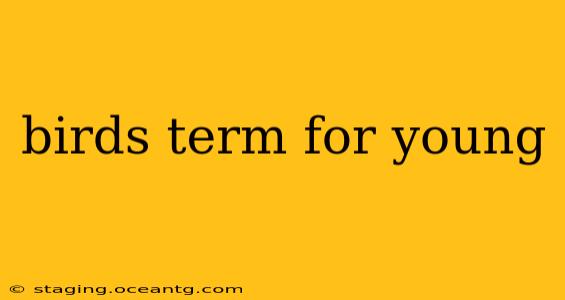Understanding avian terminology can be surprisingly complex, especially when it comes to describing young birds. The term used for a young bird varies greatly depending on the species and even the stage of development. This comprehensive guide will explore the various terms used, offering clarity and insight into the fascinating world of bird development.
What is the general term for a baby bird?
While there isn't one single universally accepted term for a baby bird, chick is the most commonly used and widely understood general term. However, this term is often too broad and doesn't reflect the nuances of different species' developmental stages.
What are some other terms for young birds?
Many different terms exist, often species-specific, reflecting the unique characteristics of each bird's development. Some examples include:
-
Fledgling: This term refers to a young bird that has recently left the nest but is still dependent on its parents for food and protection. Fledglings are often clumsy and still learning to fly properly.
-
Nestling: A nestling is a young bird that is still in the nest and completely dependent on its parents for food and warmth. They are usually flightless and covered in downy feathers.
-
Squab: This term is specifically used for the young of pigeons and doves. Squabs are particularly vulnerable and require constant parental care.
-
Cygnet: This refers to a young swan.
-
Gosling: This term is used for a young goose.
-
Duckling: A young duck.
-
Poult: This is the term for the young of various game birds, including turkeys, chickens, and pheasants.
What is the difference between a chick and a fledgling?
The key difference lies in their level of independence. A chick is a very young bird, usually still in the nest and entirely dependent on its parents. A fledgling, on the other hand, has left the nest, although it may still be quite dependent on its parents for food and protection for several weeks.
How do I identify a young bird?
Identifying a young bird often requires careful observation and consideration of several factors:
- Appearance: Young birds often have downy feathers or are sparsely feathered compared to adults. They may also have different coloration patterns.
- Behavior: Young birds are usually less skilled at flying and foraging than adults. They may be more vocal and rely on their parents for food.
- Location: The presence of a nest or adult birds nearby can be a strong indicator that you are observing a young bird.
Remember, if you find a young bird that appears injured or orphaned, it's crucial to contact a wildlife rehabilitator or local animal rescue organization for assistance. Do not attempt to care for it yourself without proper training and licensing.
What should I do if I find a baby bird that has fallen out of its nest?
Finding a seemingly abandoned baby bird can be upsetting, but in many cases, the parents are still nearby and are monitoring the situation. Unless the bird is injured or in immediate danger (e.g., from predators or traffic), it's usually best to leave it alone. The parents will usually return to care for their young. However, if the bird appears injured or is in danger, contact a wildlife rehabilitator immediately for help.
This guide provides a basic understanding of the terminology surrounding young birds. Further research into specific species will provide more detailed information about their developmental stages and the appropriate terms for their young. Remember, respecting wildlife and their natural habitats is crucial for their survival.
